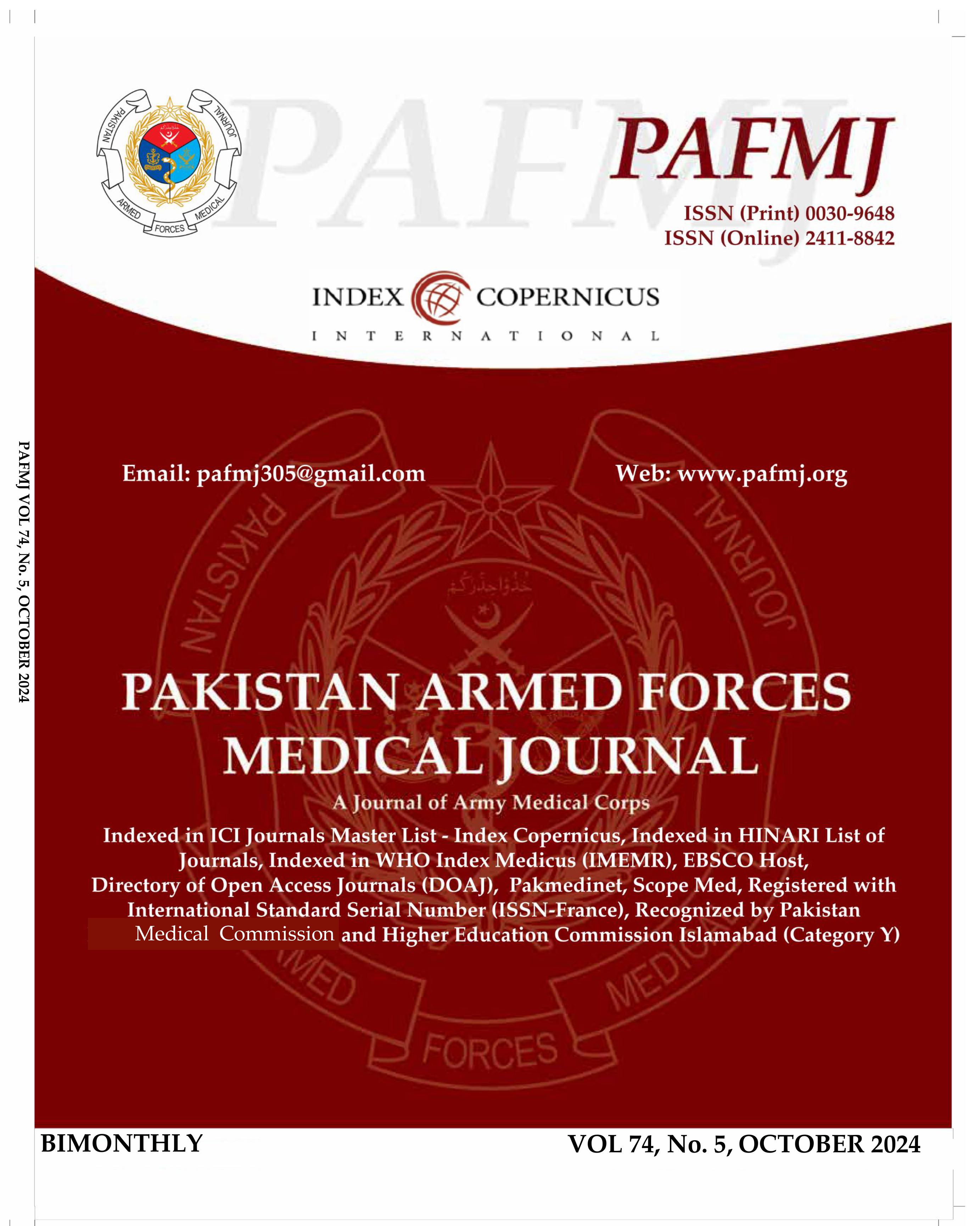Hysterosalpingographic Pattern of Primary Sub-fertility and Secondary Sub-fertility in Women of Reproductive Age
DOI:
https://doi.org/10.51253/pafmj.v74i5.5394Keywords:
Hysterosalpingography, Laparoscopy, Pelvic Inflammatory Disease, Sub-Fertility, Tubal Blockage.Abstract
Objective: To evaluate the structural abnormalities of uterus and fallopian tubes in women diagnosed with primary and Secondary Sub-fertility using hysterosalpingogram.
Study Design: Cross-sectional study.
Place and Duration of Study: Armed Forces Institute of Radiology and Imaging, Rawalpindi Pakistan, from Jul to Nov 2019.
Methodology: This study investigated potential anatomical causes of primary and secondary subfertility in women of reproductive age. A total of 500 participants, referred from Gynecology and Obstetrics Departments, underwent hysterosalpingography during the pre-proliferative phase following comprehensive medical history assessment.
Results: Out 500 women, 340(68.0%) had Primary Sub-fertility while 160(32%) had Secondary Sub-fertility. Mean age of presentation was 31.5±3.5 years. Bilateral free peritoneal spill was recorded in 340(68%) patients. Unilateral tubal blockage was present in 50(10%) patients while bilateral tubal blockage was observed in 40(8.0%) patients. Bilateral hydrosalpinx was present in 15(3 %) women. Patients with uterine congenital anomalies were also examined, and bicornuate uterus was seen in 25(5%) women and unicornuate uterus was noted in the same number, that is, 25(5%) women.
Conclusion: Hysterosalpingography is a baseline assessment test done for evaluation of patency of uterus and uterine tubes. Positive hysterosalpingography cases were more prevalent in Secondary Sub-fertility. Tubal abnormalities were more commonly observed as compared to uterine cavity pathologies. Secondary Sub-fertility was found to be more associated with older age groups.
Downloads
References
Mascarenhas MN, Flaxman SR, Boerma T, Vanderpoel S, Stevens GA. National, regional, and global trends in infertility prevalence since 1990: A systematic analysis of 277 health surveys. PLOS Med 2012; 9(12): e1001356.
https://doi.org/10.1371/journal.pmed.1001356
Dieter AA, Wilkins MF, Wu JM. Epidemiological trends, and future care needs for pelvic floor disorders. Curr Opin Obstet Gynecol 2015; 27(5): 380–384.
https://doi.org/10.1097/GCO.0000000000000204
Deshpande PS, Gupta AS. Causes, and prevalence of factors causing infertility in a public health facility. J Hum Reprod Sci 2019; 12(4): 287. https://doi.org/10.4103/jhrs.JHRS_140_18
Ali S, Sophie R, Imam AM, Khan FI, Ali SF, Shaikh A, et al. Knowledge, perceptions, and myths regarding infertility among selected adult population in Pakistan: A cross-sectional study. BMC Public Health 2011; 11(1): 760.
https://doi.org/10.1186/1471-2458-11-760
Omidiji OA, Toyobo OO, Adegbola O, Fatade A, Olowoyeye OA. Hysterosalpingographic findings in infertility – what has changed over the years? Afr Health Sci 2019; 19(2): 1866.
https://doi.org/10.4314/ahs.v19i2.49
Danfulani M, Mohammed MS, Ahmed SS, Haruna YG. Hystero-salpingographic findings in women with infertility in Sokoto North Western Nigeria. Afr J Med Health Sci 2014; 13: 19–23.
Olamijuwon E, Odimegwu C, Chemhaka G. Involuntary childlessness, and marital infidelity among women in Sub-Saharan African countries: An assessment of the moderating role of women’s education. Arch Sex Behav 2021; 50(2): 601–614.
https://doi.org/10.1007/s10508-020-01810-0
Ghuman N, Singh P, Raikar S. Male infertility-evaluation and management at a glance. Fertil Sci Res 2020; 7(1): 26.
https://doi.org/10.4103/fsr.fsr_24_20
Anwar S, Anwar A. Infertility: A review on causes, treatment, and management. Infertility 2016; 2(6): 5.
Dyer SJ, Abrahams N, Mokoena NE, van der Spuy ZM. ‘You are a man because you have children’: Experiences, reproductive health knowledge and treatment-seeking behaviour among men suffering from couple infertility in South Africa. Hum Reprod 2004; 19(4): 960–967. https://doi.org/10.1093/humrep/deh195
Onwuchekwa CR, Oriji VK. Hysterosalpingographic (HSG) pattern of infertility in women of reproductive age. J Hum Reprod Sci 2017; 10(3): 178–184.
https://doi.org/10.4103/jhrs.JHRS_86_17
Aziz MU, Anwar S, Mahmood S. Hysterosalpingographic evaluation of primary and secondary infertility. Pak J Med Sci 2015; 31(5): 1188–1191.
https://doi.org/10.12669/pjms.315.7730
Jitchanwichai A, Soonthornpun K. Effect of premedication hyoscine-N-butylbromide before hysterosalpingography for diagnosis of proximal tubal obstruction in infertile women: A randomized double-blind controlled trial. J Minim Invasive Gynecol 2019; 26(1): 110–116.
https://doi.org/10.1016/j.jmig.2018.07.012
Margaux Becker V, Silver S, Seufert R, Muensterer OJ. The association of appendectomy, adhesions, tubal pathology, and female infertility. JSLS 2019; 23(1): e2018.00099.
https://doi.org/10.4293/JSLS.2018.00099
Bukar M, Takai U, Mustapha Z, Tahir A. Hysterosalpingo-graphic findings in infertile women: A seven-year review. Niger J Clin Pract 2011; 14(2): 168.
https://doi.org/10.4103/1119-3077.84027
Foroozanfard F, Sadat Z. Diagnostic value of hysterosalpingo-graphy and laparoscopy for tubal patency in infertile women. Nurs Midwifery Stud 2013; 2(2): 188–192.
https://doi.org/10.5812/nms.11451
Reyes-Muñoz E, Vitale SG, Alvarado-Rosales D, Iyune-Cojab E, Vitagliano A, Lohmeyer FM, et al. Müllerian anomalies prevalence diagnosed by hysteroscopy and laparoscopy in Mexican infertile women: Results from a cohort study. Diagnostics 2019; 9(4): 16.
https://doi.org/10.3390/diagnostics904016
Pattern of congenital uterine anomalies among infertile women with and without recurrent miscarriages, in Southwest Nigeria. Crit Care Obstet Gynecol 2015; 1(1): 9.
Downloads
Published
Issue
Section
License
Copyright (c) 2024 Anashia Kayani, Raheel Khan, Tariq Saeed Siddiqui, Atiq Ur Rehman, Rizwan Ahmed, Yasir Khan

This work is licensed under a Creative Commons Attribution-NonCommercial 4.0 International License.















